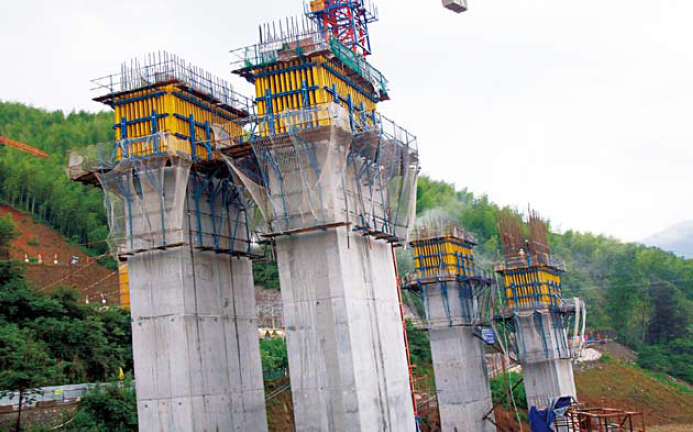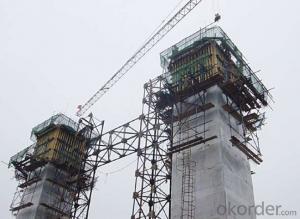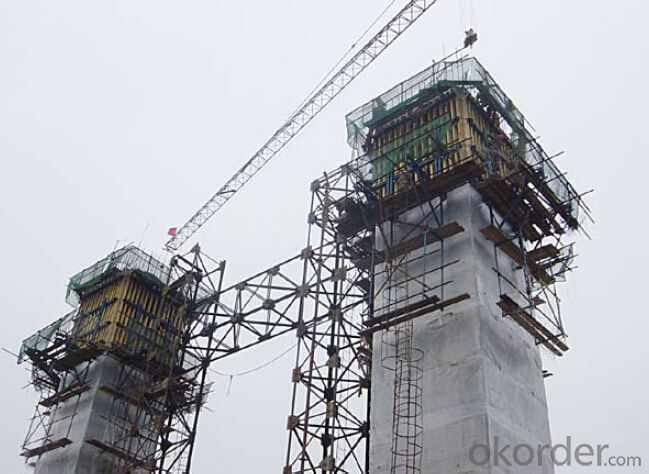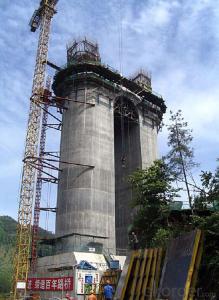Climbing Bracket for Formwork and Scaffolding system
- Loading Port:
- Tianjin
- Payment Terms:
- TT OR LC
- Min Order Qty:
- 50 m²
- Supply Capability:
- 1000 m²/month
OKorder Service Pledge
OKorder Financial Service
You Might Also Like
Climbing Bracket CB240 & CB210
They are framework brackets for supporting large-area wall formwork.
Typical applications for the CB240&CB210 are pier and column/shear wall/core walll/ in the
building.
CB210 has smaller size than CB240, it will be cost effective in some condition.
Characteristics:
◆ High bearing capacity
The high loading capacity of the brackets allow very large scaffold units. This saves the number
anchor points required as well as reducing climbing times.
◆ Simple moving procedure by crane
Through the strong connection of formwork together with the climbing scaffold, both can be moved
as a single climbing unit by crane. Thus valuable time-savings can be achieved.
◆ Fast striking process without a crane
With the retrusive set, large formwork elements can also be retracted quickly and a minimum of
effort.
◆ Safe with work platform
The platforms have assembled firmly with bracket and will be climbing together, without scaffolding
but can work safely in spite of your high location.


- Q: Can steel formwork be used for tunnel construction projects?
- Steel formwork is indeed suitable for tunnel construction projects. Its durability allows it to withstand the pressure and forces exerted during tunnel construction. Moreover, it provides a robust and stable structure for pouring concrete and forming the tunnel walls. An added advantage is that steel formwork is reusable, making it a cost-effective option for tunnel construction projects. Furthermore, steel formwork can be easily tailored to meet the precise requirements of the tunnel design, enhancing efficiency and precision during construction. In conclusion, steel formwork's strength, durability, and flexibility make it an excellent choice for tunnel construction projects.
- Q: Can steel formwork be used for complex architectural designs?
- Yes, steel formwork can be used for complex architectural designs. Steel formwork offers high strength and durability, allowing it to withstand the pressure exerted by complex architectural designs. Additionally, its versatility allows for intricate shapes and designs to be achieved with precision and accuracy.
- Q: Can steel formwork be used in areas with limited construction space or tight site constraints?
- Areas with limited construction space or tight site constraints can benefit from the use of steel formwork. This is because steel formwork is known for its versatility and adaptability, making it suitable for various construction projects, even those with limited space. One of the main advantages of steel formwork in these situations is its strength and durability. It can withstand high pressure and heavy loads, allowing it to be used in confined areas without compromising its structural integrity. This makes it an ideal choice for areas with limited construction space or tight site constraints. Additionally, steel formwork is highly flexible and can be easily adjusted or modified to fit the available space. It can be customized to different shapes and sizes, making it suitable for complex or irregularly shaped areas. This adaptability makes steel formwork a practical solution for construction projects with limited space. Moreover, steel formwork is reusable and can be dismantled and reassembled in different locations. This is particularly advantageous in areas with tight site constraints, as it allows the formwork to be easily moved and reused in different parts of the construction site. This not only saves time and effort but also reduces the need for additional formwork materials. Overall, steel formwork is a suitable choice for areas with limited construction space or tight site constraints. Its strength, adaptability, and reusability make it a practical solution for various construction projects, ensuring efficient and effective use of the available space.
- Q: How does steel formwork contribute to the overall safety of workers?
- Steel formwork contributes to the overall safety of workers in several ways. Firstly, steel formwork is known for its strength and durability, providing a stable and secure structure for workers to perform their tasks. This stability minimizes the risk of accidents and collapses, ensuring the safety of workers. Additionally, steel formwork is designed to be fire-resistant, offering protection in case of fire emergencies. This feature significantly reduces the risk of injuries and provides workers with valuable time to evacuate the area safely. Moreover, steel formwork is engineered to be resistant to various weather conditions, such as strong winds and heavy rains. This resistance prevents formwork from becoming unstable or collapsing during adverse weather, minimizing the risk of accidents and injuries for workers on-site. Furthermore, steel formwork is typically designed with safety features such as non-slip surfaces and handrails, enhancing worker safety by providing better grip and stability when moving around the structure. These features help prevent slips, trips, and falls, which are common causes of accidents on construction sites. Another important aspect is that steel formwork is reusable and can be easily assembled and disassembled. This reduces the need for workers to carry heavy materials or tools, decreasing the risk of strain injuries and fatigue-related accidents. Lastly, steel formwork is designed to ensure proper support and alignment, minimizing the risk of structural failures or collapses during concrete pouring. This precise alignment ensures the stability of the structure and reduces the likelihood of accidents that could endanger workers' safety. In conclusion, steel formwork plays a crucial role in enhancing the overall safety of workers. Its strength, durability, fire resistance, weather resistance, non-slip surfaces, and proper support contribute significantly to creating a secure working environment, reducing the risk of accidents, injuries, and structural failures.
- Q: How does steel formwork perform in earthquake-prone areas?
- Steel formwork performs well in earthquake-prone areas due to its inherent strength and durability. Steel is a highly resilient material that can withstand the forces generated during an earthquake. It has excellent tensile strength, which means it can resist bending and deformation under the seismic loads. In earthquake-prone areas, it is crucial to ensure the stability and safety of structures. Steel formwork provides a robust and reliable solution for constructing reinforced concrete structures that can withstand seismic activity. The stability and rigidity of steel formwork help in maintaining the structural integrity of the concrete elements, even during strong ground shaking. Moreover, steel formwork offers flexibility in design and construction. It can be easily adjusted or modified to accommodate changes in architectural or engineering requirements. This adaptability is particularly advantageous in earthquake-prone areas where design considerations and building codes often evolve to enhance seismic resilience. Another advantage of steel formwork in earthquake-prone areas is its reusability. Steel formwork can be dismantled and reused multiple times, making it a cost-effective and sustainable choice. This feature is essential in regions with frequent seismic activity, as it allows for efficient and economical construction practices. Furthermore, steel formwork provides better control over the quality of concrete structures. It helps in achieving precise dimensions, shape, and surface finish, which are crucial for seismic performance. The accuracy and consistency offered by steel formwork contribute to the overall structural stability and reduce the risk of structural failure during an earthquake. However, it is important to note that the performance of steel formwork in earthquake-prone areas also depends on proper engineering design, construction techniques, and adherence to building codes and regulations. The collaboration of experienced structural engineers, architects, and construction professionals is essential to ensure the effective utilization of steel formwork in earthquake-resistant construction.
- Q: Can steel formwork be used for precast concrete balconies?
- Yes, steel formwork can be used for precast concrete balconies. Steel formwork offers durability, strength, and stability, making it a suitable option for constructing precast concrete balconies. It provides a smooth finish to the concrete surface and allows for easy demolding and reusability, increasing efficiency in the construction process.
- Q: How does steel formwork affect the overall speed of construction?
- Steel formwork can greatly accelerate the speed of construction due to its durability and reusability. Unlike traditional wooden formwork, steel formwork can withstand multiple uses without being damaged or deformed, allowing for faster assembly and dismantling of formwork systems. Its robustness also enables it to bear heavier loads, reducing the need for additional support structures. Additionally, steel formwork provides a smooth and uniform surface finish, reducing the time required for plastering and other finishing tasks. Overall, the use of steel formwork contributes to increased efficiency, shorter construction cycles, and faster project completion.
- Q: Can steel formwork be used for staircases and ramps?
- Steel formwork is indeed capable of being utilized for the construction of staircases and ramps. It possesses a great deal of versatility and durability, making it an ideal choice for the creation of intricate shapes and structures. The strength and stability that it offers are essential for supporting the weight and loadings associated with staircases and ramps. Moreover, the assembly and disassembly of steel formwork can be accomplished with ease, allowing for efficient construction and customization of staircases and ramps. Its flexibility enables the creation of diverse designs and sizes that cater specifically to the requirements of a given project. In conclusion, when considering the construction of staircases and ramps, the use of steel formwork is highly suitable due to its strength, durability, versatility, and user-friendly nature.
- Q: Can steel formwork be used for both slab and column construction?
- Yes, steel formwork can be used for both slab and column construction. Steel formwork offers several advantages over other types of formwork, such as wood or plastic. It is highly durable and can withstand the pressure exerted by fresh concrete, making it suitable for use in both slab and column construction. For slab construction, steel formwork provides a strong and rigid support system, ensuring that the concrete is poured and cured in the desired shape and dimensions. The steel panels can be easily assembled and disassembled, allowing for efficient and repeated use on multiple projects. This saves both time and money in the long run. Similarly, steel formwork can also be used for column construction. The adjustable panels can be easily customized to various column sizes and shapes, providing flexibility in design. Steel formwork also offers a smooth surface finish, resulting in high-quality columns. Moreover, steel formwork is resistant to warping, swelling, and shrinking, which can occur with other types of formwork materials. This ensures that the concrete structure is built accurately and maintains its structural integrity over time. Overall, steel formwork is a versatile and reliable option for both slab and column construction. Its strength, durability, and ease of use make it a popular choice among construction professionals.
- Q: Are there any specific considerations for using steel formwork in areas with limited power supply?
- Yes, there are several specific considerations for using steel formwork in areas with limited power supply. Firstly, steel formwork typically requires power tools for assembly and disassembly. In areas with limited power supply, it may be challenging to operate these tools efficiently. Alternative methods such as manual tools or hand-held equipment may need to be used, which can significantly increase the time and labor required for formwork installation and removal. Secondly, steel formwork often requires welding or cutting, which typically relies on electricity. In areas with limited power supply, finding suitable alternatives for these processes becomes crucial. For example, gas-powered welding machines or oxy-fuel cutting equipment may need to be considered. However, these alternatives come with their own set of challenges, such as obtaining and storing fuel safely. Additionally, areas with limited power supply may also face issues related to lighting. Adequate lighting is essential during formwork installation and concrete pouring to ensure accuracy and safety. Using alternative lighting sources such as battery-powered or solar-powered lights may be necessary. Furthermore, steel formwork often requires proper cleaning and maintenance to ensure its longevity and reusability. Cleaning equipment, such as pressure washers or power scrubbers, may not be readily available in areas with limited power supply. In such cases, manual cleaning methods or low-power alternatives may need to be employed. Lastly, power supply limitations may also affect the overall productivity and efficiency of the construction project. With limited power, it may be necessary to carefully plan and schedule the use of power-intensive equipment, such as concrete mixers or pumps, to minimize disruptions and maximize the available power resources. In conclusion, using steel formwork in areas with limited power supply requires careful consideration and planning. Alternative methods, tools, and equipment may need to be employed to overcome the challenges posed by the lack of power availability. It is essential to assess the specific requirements of the project and consult with experts to ensure the successful implementation of steel formwork in such areas.
Send your message to us
Climbing Bracket for Formwork and Scaffolding system
- Loading Port:
- Tianjin
- Payment Terms:
- TT OR LC
- Min Order Qty:
- 50 m²
- Supply Capability:
- 1000 m²/month
OKorder Service Pledge
OKorder Financial Service
Similar products
Hot products
Hot Searches

















